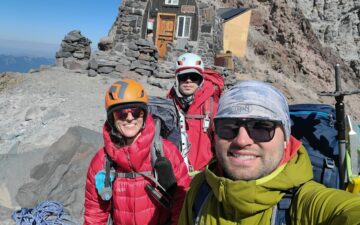Bursting of the Kakhovka Dam: Implications for the Black Sea

On 6th June, the Kakhovka dam in southern Ukraine burst, causing flooding and a new humanitarian crisis in a region already reeling from the effects of the ongoing war. The damaged dam not only flooded vast areas, but also caused a number of environmental and ecological problems.
Heavy rains and thunderstorms began immediately after the dam burst, which deteriorated the situation, making it even more difficult to evacuate people and deliver humanitarian aid. The impact of the incident went far beyond the immediate humanitarian concerns.
As the water receded, it became evident that the dam burst turned into a massive environmental disaster. The flooding triggered a wave of pollution that had far-reaching consequences for the Black Sea and its neighboring regions. From significant faecal contamination due to cesspools and manure pits being washed away to industrial pollution, the waters of the Black Sea bore the brunt of the disaster. The impact on marine life, water quality and human health has been the subject of intense research and analysis.
In this article, journalists from Georgian newsroom JAM-News, Romanian G4Media, Bulgarian Nauka and Ukrainian Donbass News analyze the environmental consequences of the Kakhovka dam burst, examining the immediate and long-term consequences of the disaster. Through the experts` opinions and analyses, we try to understand the complex consequences of the dam burst for the Black Sea and its neighboring regions.
Ecological and environmental consequences
The flood waters caused by the dam burst carried a variety of pollutants that had a significant impact on the water quality, marine life and human health.
One of the most pressing concerns was pollution caused by floodwaters. Ukrainian Health Minister Viktor Liashko declared “significant faecal pollution” and warned against eating or swimming in affected water bodies due to the risk of infectious diseases. Ukrainian authorities advised their citizens to refrain from swimming in the water bodies affected by the disaster and from eating fish from them for fear of outbreaks of gastrointestinal infections.
Mulțumim că citești ZdG!
Ajută-ne să continuăm să furnizăm informații esențiale — donează pentru jurnalismul nostru.
In addition to faecal contamination, the floodwaters also carried industrial pollution. Dozens of chemical and petrochemical plants were flooded, causing industrial water pollution. According to Greenpeace, around 150 tonnes of motor oil leaked into the water from flooded refineries, fuel stations, power plants and warehouses in the first few days of the disaster.
As a result, contaminated water reached the Black Sea through Dnieper Bay, leading to a ban on swimming and fishing in Odesa Oblast. Water samples from this region contained salmonella, rotavirus, astrovirus, cholera vibrio, parahaemolyticus, eggs and larvae of human and animal helminths, and a significantly higher LPC (lactose-positive coli) index. Contamination was caused by pesticides, chemicals, sewage, cemetery remains, animal carcasses and other waste that washed into the Black Sea downstream of the Dnieper River after the dam burst.
“We used to have a problem – the sea used to bloom all the time because of the fertilisers that went down the rivers into the sea, and it would bloom periodically. But now large amounts [of fertiliser] that had accumulated in the Kakhovka reservoir have been released into the sea. It has not disappeared, it will not disappear for a long time, and we will see its consequences for a long time to come,” said Yurii Kvach, the leading researcher at the Institute of Marine Biology of the National Academy of Sciences of Ukraine.
The impact of the dam burst was not limited to direct water pollution. The massive inflow of fresh water reduced the salinity of the water in the northern part of the Black Sea by up to three times the normal level. The reduced salinity of water has a serious negative impact on local flora and fauna, causing high mortality rates in many species.
“The desalinated water actually appeared at a time of spawning. And if the fish can swim away from the shore, the fry and eggs would not ‘escape’. The fry and eggs died. The fish will come back later, they will spawn again. But there was a change in the structure of the ecosystem,” says Yurii Kvach.
According to scientists’ predictions, the mussels should have survived, because they can exist in oxygen-free conditions for some time. We hoped that when polluted water came in, the mussels would “recognise” it.
“This water, with a salinity of 3-4 ppm, was lethal for them. We hoped they would just shut down and survive this time, but they didn’t. We saw mass mortality of mussels in the coastal shallows within a week… Now we are observing that the mussels are recovering a little bit, they are starting to appear, but they need to grow,” says the scientist.
Vladyslav Balynskyi, an eco-activist from Odesa and representative of the Green Leaf public organisation, is also watching the mussels die. According to him, the colony on the breakwater suffered the most, with about 50% of mussels dying near the shore.
The long-term ecological and environmental consequences of the dam burst continue to be of concern. Pollution combined with reduced salinity has a potential to disrupt the delicate balance of the Black Sea ecosystem and affect marine life for many years to come.
Response and mitigation measures
The environmental and ecological consequences of the Kakhovka dam burst forced various organisations and authorities to take prompt measures to mitigate the effects of the disaster and ensure the safety of the affected population, marine life and environment.
Immediately after the dam burst, the World Health Organization (WHO) initiated rapid delivery of medical kits to meet the growing medical needs of the disaster-affected population throughout the region. These efforts were aimed at addressing health issues resulting from flooding and environmental pollution.
Since the dam burst, various organisations and institutions in Bulgaria and Romania have been actively monitoring water quality in the Black Sea. Extensive monitoring, including water and sediment sampling, as well as fish monitoring, has been carried out at more than 25 locations along the entire European coast of the Black Sea. The results of measurements of heavy metals, polycyclic aromatic hydrocarbons, caesium-137 and many other elements were within the permissible limits set by the European Union.
The Black Sea Basin Directorate – Varna also carries out regular monitoring and publishes analysis results on its website. Although elevated levels of nitrogen and copper have been found in some locations, the results of analyses for other elements and microbiological monitoring indicate that their levels are low and within the established limits.
In addition to monitoring, the authorities are taking measures to reduce the dam burst impact on marine life and the environment. To protect human health and prevent potentially contaminated fish consumption, a ban on swimming and fishing in Odesa Oblast has been introduced. Efforts have also been made to clean up the pollution caused by flood waters and to restore the affected ecosystems.
The work to deal with the consequences of flooding were carried out by joint efforts of various organisations, including international ones, and authorities. Continuous monitoring of seawater and measures taken to deal with the consequences of the dam burst played a crucial role in ensuring the safety of marine life, human health and the environment.
Expert reviews and opinions
The ecological and environmental consequences of the Kakhovka dam burst have been analysed and discussed by experts. Their opinions provide a deeper understanding of the aftermath of disaster and possible long-term consequences for the Black Sea ecosystem.
Nikolay Valchev, Director of the Institute of Oceanology at the Bulgarian Academy of Sciences (BAS), said that currently strong winds are keeping the pollution close to the coast, so it will reach the Bulgarian coast quite slowly and will encounter many obstacles. He noted that the contamination plume will continue moving southwards along the coast towards Romania and Bulgaria, but rather slowly, with decreasing concentration of pollutants.
Adrian Stanica, director of the Romanian National Institute of Geology and Marine Geoecology (GeoEcoMar), noted that the dam burst caused a huge amount of sediments to wash away containing various pollutants, organic materials and waste. According to him, the most significant environmental impact will be evidenced in Odessa Oblast and at the mouth of the Dnieper River, and as one moves away from the mouth of the Dnieper River, the impact on the marine environment will be significantly reduced by dilution.
Significant environmental impacts will be evident in the long term: all coarse sediments, remnants of houses and vegetation, washed away by the Dnieper River and becoming sediments, will be added to pollutants of the earlier periods. Identifying these elements will require detailed analysis of the seabed contents and, most likely, clean-up operations. Again, without detailed periodic studies, the process of comprehensive decision-making will remain extremely challenging. However, experience suggests that the most significant environmental impacts will continue to be in Odesa Oblast and at the mouth of the Dnieper River. But with distance from the mouth of the Dnieper River, the impact on the marine environment will be significantly reduced by dilution,” says Adrian Stanica.
Violin Raikov, employee of the Institute of Oceanology at the Bulgarian Academy of Science said that large-scale monitoring was conducted at more than 25 locations along the entire Black Sea coast, and measurements of heavy metals, polycyclic aromatic hydrocarbons, caesium-137 and many other elements were within the permissible limits set by the European Union. He also noted that the Danube, which is much larger than the Dnieper River, serves as a natural barrier to polluted waters reaching the Romanian coast.
Dimitar Berov, marine ecologist and senior researcher at the Laboratory of Marine Ecology at the Institute of Biodiversity of the Bulgarian Academy of Science, PhD in Biology, confirmed that the test results show no reason to panic. He said that the further south we moved from the affected area, the more pollutant concentration would decrease. He predicted that by the time the waters reach the northern coast of Bulgaria, the concentration of the pollutants will be well below the level that poses a serious health risk or has toxic effects.
The Ministry of Environmental Protection of Georgia informed JAMnews that the water in the Black Sea off the country’s coast is safe. Water samples are taken every ten days at 12 stations, from different depths. The values of 59 parameters determined in the Black Sea water samples are within the limits.
However, apart from official research, no alternative samples of the Black Sea water are taken in Georgia. According to ecologists, this is an expensive process – it costs millions, and the non-governmental sector does not have such funds.
Therefore, the ecologists’ opinion, whether the Black Sea is safe or not, is based only on official research.
“Surface currents go north-west, passing the territory adjacent to Romania, Bulgaria, Varna, then the Bosphorus and the Anatolian plain, start their way south, splitting into two currents near Georgia. You can imagine how many hundreds of kilometers this current has to pass for all this – in this case, pollutants – to reach Georgia,” says Kakha Guchmanidze, ecologist from Batumi.
Another ecologist, Nino Chchobadze, Chairman of the Green Movement “Friends of the Earth — Georgia”, says it will take almost a year for the flow of polluted water to reach Georgia:
“The flow of water from Odessa will reach us in about 8-11 months. It is difficult to predict what exactly this water will bring to Georgia. Water has the ability to filter itself, we should assume that it will filter dangerous substances by itself”.
According to her, it should be noted that a large amount of hazardous substances has already fallen on the banks of the Dnieper River. And what is left in the water is likely to slowly settle on the way:
“Now we only have to wait and monitor the water conditions. In the meantime, we should be in close contact with the countries of the Black Sea basin.”
Explosion near Romanian resort
An explosion, probably caused by a sea mine, occurred on the morning of 14 August near the Romanian resort village of Costinești. According to preliminary reports, there may be another explosive object in the water, so the Romanian Naval Forces sent specially trained divers to search for and neutralize the dangerous object. Romanian Naval Forces spokesman, Colonel Corneliu Pavel said the danger of drifting sea mines has increased after Russia’s full-scale invasion of Ukraine. On the day of the explosion, strong winds blew from the sea to the shore, and divers were sent to Costinești to investigate the incident.
The explosion near the Romanian resort village of Costinesti serves as a reminder of the ongoing conflict in Ukraine and its potential impact on the Black Sea region.
Authors:
Victoria Savitskaya (Donbass News),
Radoslav Todorov (Nauka),
Nino Narimanishvili (JAMnews),
Andrea Pavel and Ioana Morovan (G4Media),
“Mediaset”



